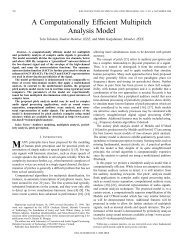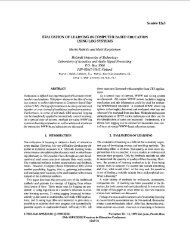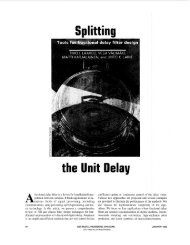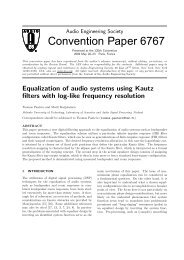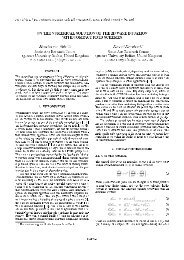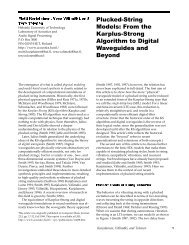Physical Modeling of Plucked String Instruments with Application to ...
Physical Modeling of Plucked String Instruments with Application to ...
Physical Modeling of Plucked String Instruments with Application to ...
Create successful ePaper yourself
Turn your PDF publications into a flip-book with our unique Google optimized e-Paper software.
IIVALIM_.KI ET AL.PAPERSsecond (30 MFLOPS, 15 MIPS). Our experience was, PC platforms. We use commercially available DSP boards.however, that this limit cannot be reached in practice, Our developments include using a multiprocessor enexceptin special cases when register, pipeline, and mem- vironment for running several instruments in parallelory conflicts can be <strong>to</strong>tally avoided. Our hand-optimized or for a more detailed simulation <strong>of</strong> the instruments,assembly code taking up about 110 instructions per output including nonlinear effects. We have experimented <strong>with</strong>sample for a single string was able <strong>to</strong> run six strings in a system containing two TMS320C31 processors, whichreal time <strong>with</strong> a sampling rate <strong>of</strong> 22 kHz, including host are less expensive and slightly reduced versions <strong>of</strong> thecommunication and parameter calculation. However, this TMS320C30, and we have built a more advanced systemwas found <strong>to</strong> be adequate for producing excellent plucked using TMS320C40 floating-point processors, which supstringsounds since there is not much energy in the spec- port multiprocessing in hardware [36].tram <strong>of</strong> these signals above 10 kHz.The implementation <strong>of</strong> plucked string synthesis on aAn overview <strong>of</strong> the s<strong>of</strong>tware and hardware environ- signal processor follows the principles <strong>of</strong> Fig. 9. Eachment for the real-time implementation <strong>of</strong> physical mod- substring (single polarization) consists <strong>of</strong> a ring bufferels is given in Fig. 33. Programs written in the QuickC30 delay line <strong>with</strong> third-order Lagrange interpolation (forenvironment [47] can be run on different hardware plat- fine-tuning) and a loop filter. Table look-up is used forforms <strong>with</strong>out modification. All hardware-dependent de- computing the interpola<strong>to</strong>r coefficients from pitch infortailsare hidden from the application by the use <strong>of</strong> spe- mation. Also the loop filter parameters have been tablecialized macros and functions. So far the QuickC30 coded. <strong>String</strong> excitations are read from wavetables thatsystem has been implemented on the Macin<strong>to</strong>sh and the have been constructed using inverse filtering techniques.Most control parameters are MIDI-like, that is, theycover a number range from 0 <strong>to</strong> 127. The computation<strong>of</strong> the model parameters, such as the delay and loop-as possible by table look-up since computationally expensivedivisions, logarithms, and exponents are other--o._ {). filter wise parameters needed. (For andcontrol excitation parameters, filtering, see is done also as Section much6.)" 0;5 or, 015 0'2 ,,25(a)The updating <strong>of</strong> model parametersis executedevery1 ms, which has been found fast enough in most transientsandtransitions.Thereducedparameterupdaterateo.5llllis suchas necessary<strong>to</strong> inthecase<strong>of</strong> keepthecomputationalcost guitarsynthesis. lowenough,5.1 Multirate <strong>String</strong> Model-0 Astringinstrumen<strong>to</strong>ne,likemostnaturalsignals,is0 005 o l 0'15 0'2 o25 a low-pass signal whose spectrum varies through timeTimeCs) SO that high-frequency components are damped faster(b)than low-frequencycomponents. Thus it would be ad-Fig. 31. (a) Original banjo <strong>to</strong>ne. (b) Residual signal after vantageous <strong>to</strong> design a multirate synthesis model whereinversefiltering,the input sequenceis fed in at a high samplingrate, butwhere the delay line.and the loop filter Hi(z) would runat a rate considerablylower.Thisidea has alsobeenmentioned in Smith [48, p. 50]. As a result, the attack0.5-0.5-I 0.05 0.1 0,15 r 02 , (}.25(a)DSP· -0.50.1MIDI controllers0.05 0.1 Time (s) 0.15 0'2 0.25 other MIDI applications _ _,(b)Fig. 32. (a) Truncated residual signal. (b) Resynthesized Fig. 33. S<strong>of</strong>tware and hardware environment for real-timebanjo<strong>to</strong>ne.implementation <strong>of</strong>physicalmodels.346 J. Audio Eng. Soc., Vol. 44, No. 5, 1996 MayU






